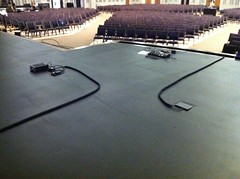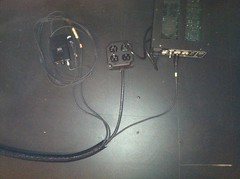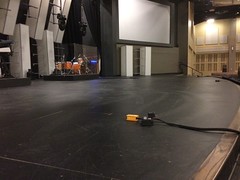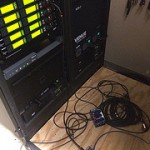
Be Professional: Setting the Stage

So I’m going to start something new that might be an ongoing series. This was inspired by some of the recent stuff we were talking about on Church Tech Weekly about creating a professional environment. These are just going to be simple, little posts hopefully of simple, little things that can instantly help you come across as more professional. Let’s start off by talking about setting up your stage.
Personally, I’m not the greatest person in the world at keeping a stage neat and tidy because I’m not the greatest person at keeping anything neat and tidy. I work with a lot of guys who are way better at this than me, however, I do know a few little things that can go a long way.
Step 1: Stage Plots
The first thing you need to do is know or figure out where everything is going to go. Professionals use something called Stage Plots for this. A Stage Plot is a simple diagram that shows where everything will go on stage. Consider it a map of the stage. Stage plots can be elaborate diagrams or even simple sketches on a napkin, although, napkins would be frowned upon in most professional situations. If you use Planning Center for your services, they even have a built in stage layout feature you can use for this. Regardless of what you use, you should have some kind of a document showing where everyone/everything will go.
Personally, I don’t typically put together stage plots. In my world, there are a lot of video and lighting considerations in regards to where things go on stage so I simply weigh in on them a bit if someone is going to be in a difficult place for me. For example, I strategically try and get all of the softer singers as far away from the drums as possible. However, there is a document of some sort that is created every week.
Once you know where everything is going to go you can start getting things wired up which leads to the next step.
Step 2: Consolidate
Minimize all cable runs to as few as possible. There’s nothing worse than having a ton of individual cables running all over the stage. One of my favorite ways to do this is to build my own snakes. This can easily be accomplished using something like Techflex. Techflex is a braided sleeve that can be used to encase and conceal cables. There are a lot of varieties out there, and I typically go with F6 because it’s split so you can easily add and remove things as necessary. The only downside is that Techflex can sometimes slide around on some stages if you step on it wrong, but I think it’s still better than having multiple cables to slide and trip on.
If you don’t want to or can’t use Techflex, Gaffers Tape (Gaff Tape or just Gaff) can be used to temporarily secure cables together. Gaff is no good long term, though, because over time it will leave a nasty, sticky residue on your cables. If you’re going to purchase gaff tape, do yourself a favor and get the good stuff. Whatever you do, don’t use Duct Tape. Duct Tape will leave nasty, sticky residue on your cables if it just sits in the same room with them.
Some guys like to skip Gaff and use zip-ties. Zip-ties work better over the long term, but I’m personally not a big fan because I’ve had my hands sliced up way too many times from sharp corners and edges on the connectors.
The photos on the right display some of the snakes I’ve built using Techflex. The bottom photo displays the snake we use for our bass players in our West Auditorium. There’s a line for the bass player’s signal, stereo hardwired IEM’s, and power. We can easily move this to one of two positions where our bass player might be positioned on stage, and everything stays connected and neat. This leads to the next thing.
Step 3: Use Drop Snakes
Drop snakes–sometimes also called sub-snakes–are wonderful because they can be placed or “dropped” wherever you need them and provide centralized points for connecting inputs. Drum kits and keyboard risers look especially tacky with a half dozen or more cables running off to a floor box somewhere. Using a drop snake near the drums gives you a single cable run back to your main snake or splitter and keeps the individual lines for the drums contained to the riser.
I know some people like floor boxes, but I have a pure and passionate hatred for them. They are typically only in the right place for the first couple weeks venue opens, and that’s if you’re lucky. Shortly after opening or even upon opening they are always at least one input short of what you really need. My friends Andrew Stone(Church on the Move) and Joel Yates(Newspring) have some floor boxes that are downstage and serve mostly as access points to run things under the stage, and these don’t bother me quite as much because there is some flexibility in them compared to floor boxes with permanent IO connections.
Now, I know in one of the photos above you can see one of our snakes running out of a floor box. Let me assure you, this is no longer the case because I hate floor boxes. That photo was taken before we added a couple drop snakes in our downstage trough that runs across the front of the stage–you can see those here on the left.
Personally, I prefer a trough/trench to floor boxes because there is a lot more flexibility for getting signals wherever they’re needed. They also offer a great place to mount footlights.
Step 4: Run cables from Upstage to Downstage
Whenever possible, cables should run from Upstage (the back of the stage) to Downstage (the front of the stage). Ultimately, you want to minimize the amount of cables you have downstage because that’s what ends up making your stage look messy.
When you do use cables downstage, it is best to consolidate them into a single run across the front of the stage as far downstage as possible. Sometimes this is the best bet for hardwired vocal mics and wedges. You should also try and get the main run for these downstage cables as far to the side of the stage as possible and consolidated(see Step 2).
Step 5: As Neat As Possible
In complex stage setups, it can be difficult to keep things looking neat no matter how much consolidation you do so you just have try and keep things as neat as possible. For starters, when you have excess cable, coil the excess neatly at the SOURCE and NOT at the snake. Having the excess at the source offers flexibility in case you have to move that source somewhere else on stage. It also keeps your stage boxes/floor pockets clean so when you have to troubleshoot something you don’t have a bird’s nest of cables at the inputs to sort through.
When you wrap or coil a cable, always make sure and do it “over/under”. If you don’t know how to do this, stop handling cables until you do. Seriously. Go learn this right now. Right now. Seriously. Stop everything and go learn it.
There are videos on YouTube, but there’s a great one HERE. Mastering this is an absolute must. You have have have have have to learn how to properly wrap a cable if you’re going to do anything in production.
These are just some small strategies for keeping your stage looking professional.

The panorama here and at the top of this article is a recent photo of one of our stages completely wired and ready for the band to arrive. Notice how clean the stage looks?
Our other auditorium looks very similar, although, we have a few extra snakes running from our upstage risers for guitar pedalboards since we clear that stage after the music. In both cases, the goal is to keep things as clean and open looking as possible.
If you’ve got some more strategies for keeping your stage looking professional, please add them in the comments.




 Previous Post
Previous Post Next Post
Next Post



Neat at the start, but what about pedal boards & guitar stands and the 1/4″ cable going between?
The same rules apply for cables. We keep guitar stands offstage. If they have to be onstage, I’d put them as far upstage as possible to still be within reach of the guitarist. Placing them next to back line amps would be the most likely place for me.
Great info here! With your zip ties comment I would like to offer a possible solution to the hard and or sharp edges. I found out about these from an AV installer at my work. http://www.homedepot.com/p/Xcelite-4-in-Shear-Cutter-Plier-Set-2-Piece-S2KS5/100163974 This is the two pack and is usually stocked at my local HD.
Same tool, just the cutter, but online only. http://www.homedepot.com/p/Klein-Tools-5-in-Lightweight-Flush-Cutter-D275-5/100647983
This usually cuts to no sharp edges on the waste side of the zip tie.
Thanks Dave.
We always use the flush cutter, but I still don’t like zipties because even the square connector tends to be sharp.
Sometimes I also use a ziptie gun because those also cut the ties flush.
What do you use to tie off a cable once it is wrapped up? Velcro? Cord? Do you leave it at the source or snake end?
I typically just tie the cable off loosely using the male end of the cable.
Dave,
Another option for wrapping cables is to use black silicone sealing tape. It stretches like electrical tape and doesn’t leave a residue. Plus, you can get it at home depot.
http://www.homedepot.com/p/Nashua-Tape-Stretch-and-Seal-1-in-x-3-33-yds-Black-Silicone-Sealing-Tape-684201/100206050